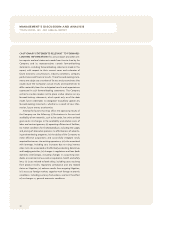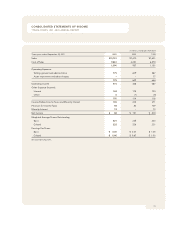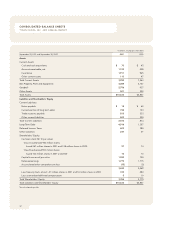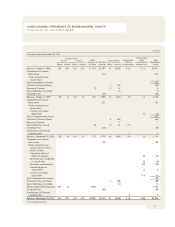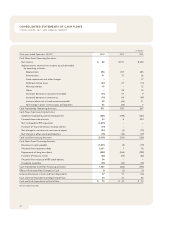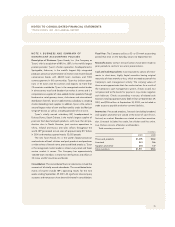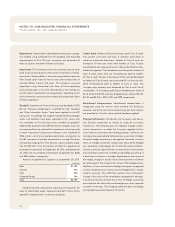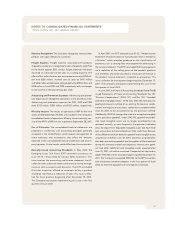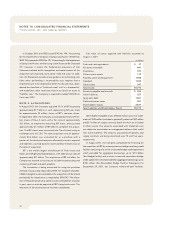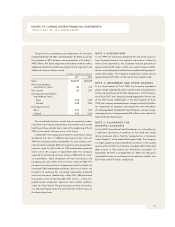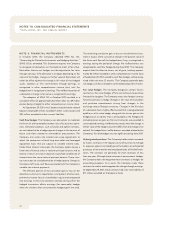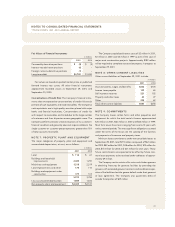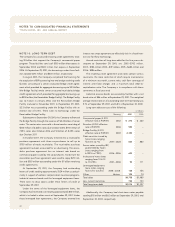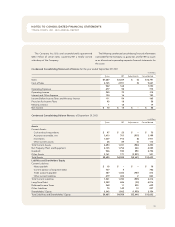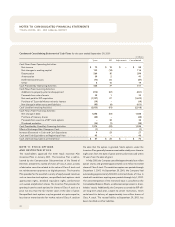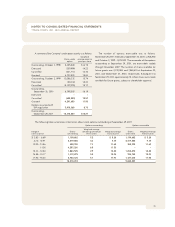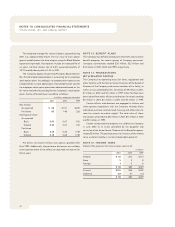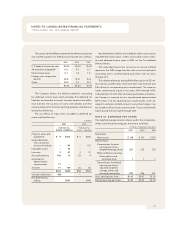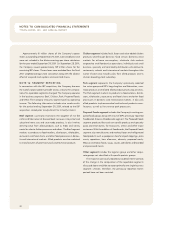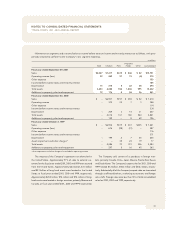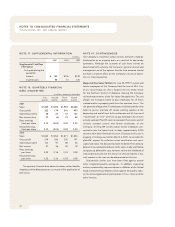Tyson Foods 2001 Annual Report Download - page 42
Download and view the complete annual report
Please find page 42 of the 2001 Tyson Foods annual report below. You can navigate through the pages in the report by either clicking on the pages listed below, or by using the keyword search tool below to find specific information within the annual report.
40
NOTES TO CONSOLIDATED FINANCIAL STATEMENTS
TYSON FOODS, INC. 2001 ANNUAL REPORT
NOTE 6: FINANCIAL INSTRUMENTS
In October 2000, the Company adopted SFAS No. 133,
“Accounting for Derivative Instruments and Hedging Activities,”
(SFAS 133) as amended. This Statement requires the Company
to recognize all derivatives on the balance sheet at fair value.
Derivatives that are not hedges must be adjusted to fair value
through earnings. If the derivative is a hedge, depending on the
nature of the hedge, changes in the fair value of derivatives will
either be offset against the change in fair value of the hedged
assets, liabilities or firm commitments through earnings, or
recognized in other comprehensive income (loss) until the
hedged item is recognized in earnings. The ineffective portion of
a derivative’s change in fair value is recognized in earnings.
The adoption of SFAS 133 in October 2000 resulted in a
cumulative effect of approximately $6 million after tax ($9 million
pretax) being charged to other comprehensive income (loss).
At September 29, 2001, the Company had derivative related
balances totaling $5 million recorded in other current assets and
$20 million recorded in other current liabilities.
Cash flow hedges: The Company uses derivatives to moderate
the financial and commodity market risks of its business opera-
tions. Derivative products, such as futures and option contracts,
are considered to be a hedge against changes in the amount of
future cash flows related to commodities procurement. The
Company also enters into interest rate swap agreements to
adjust the proportion of total long-term debt and leveraged
equipment loans that are subject to variable interest rates.
Under these interest rate swaps, the Company agrees to pay a
fixed rate of interest times a notional principal amount and to
receive in return an amount equal to a specified variable rate of
interest times the same notional principal amount. These inter-
est rate swaps are considered to be a hedge against changes in
the amount of future cash flows associated with the Company’s
variable rate interest payments.
The effective portion of the cumulative gain or loss on the
derivative instrument is reported as a component of other com-
prehensive income (loss) in shareholders’ equity and recognized
into earnings in the same period or periods during which the
hedged transaction affects earnings (for commodity hedges
when the chickens that consumed the hedged grain are sold).
The remaining cumulative gain or loss on the derivative instru-
ment in excess of the cumulative change in the present value of
the future cash flows of the hedged item, if any, is recognized in
earnings during the period of change. No ineffectiveness was
recognized on cash flow hedges during fiscal 2001. The Company
expects that the after tax losses, net of gains, totaling approxi-
mately $4 million recorded in other comprehensive income (loss)
at September 29, 2001, related to cash flow hedges, will be recog-
nized within the next 12 months. The Company generally does
not hedge cash flows related to commodities beyond 12 months.
Fair value hedges: The Company designates certain futures
contracts as fair value hedges of firm commitments to purchase
livestock for slaughter. The Company enters into foreign currency
forward contracts to hedge changes in fair value of receivables
and purchase commitments arising from changes in the
exchange rates of foreign currencies. Changes in the fair value
of a derivative that is highly effective and that is designated and
qualifies as a fair value hedge, along with the loss or gain on the
hedged asset or liability that is attributable to the hedged risk
(including losses or gains on firm commitments), are recorded in
current period earnings. Ineffectiveness results when the change in
the fair value of the hedge instrument differs from the change in fair
value of the hedged item. Ineffectiveness recorded related to the
Company’s fair value hedges was not significant during fiscal 2001.
Undesignated positions: The Company holds certain commod-
ity futures contracts in the regular course of business to manage
its exposure against commodity price fluctuations on anticipated
purchases of raw materials and anticipated sales of finished inven-
tories. The contracts are generally for short durations of less
than one year. Although these instruments are economic hedges,
the Company does not designate these contracts as hedges for
accounting purposes. As a result, the Company marks these
contracts to market and recognizes the change through earnings.
At September 29, 2001, these contracts had a fair value liability of
$11 million recorded on the balance sheet.


